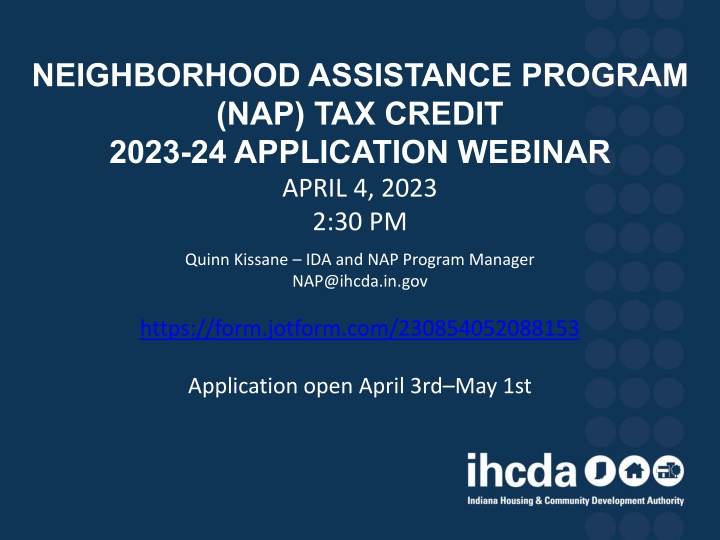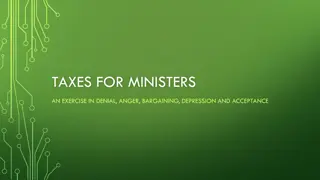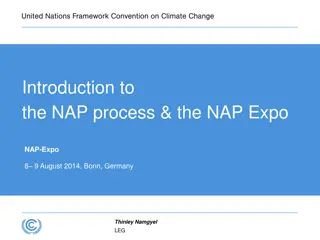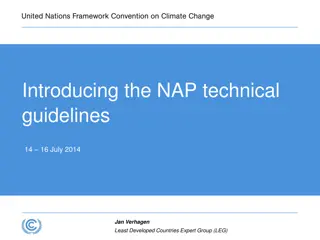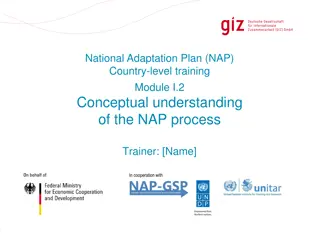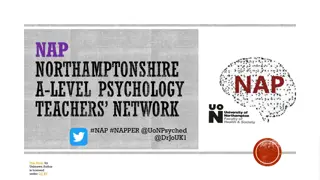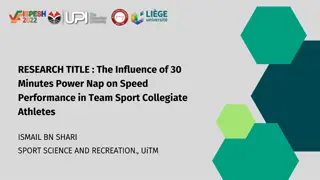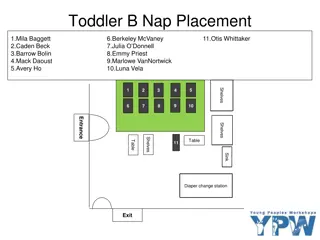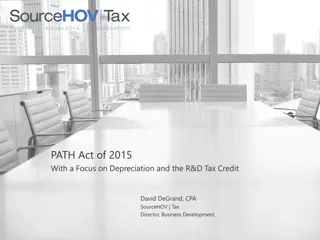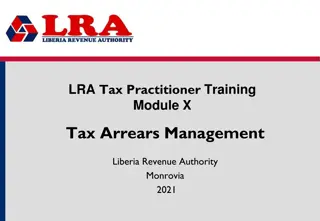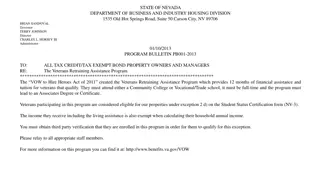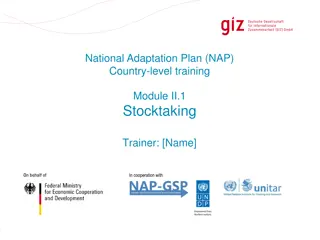Neighborhood Assistance Program (NAP) Tax Credit 2023-24 Application Details
The Neighborhood Assistance Program (NAP) in Indiana offers $2.5 million in tax credits annually to non-profit organizations for neighborhood projects. The program provides a tax credit worth 50% of the donation value, administered by the Indiana Housing and Community Development Authority (IHCDA). The 2023-24 NAP program cycle involves applying, getting approved, distributing credits, and reporting donations. The application timeline, including important dates, is outlined for interested participants.
Download Presentation

Please find below an Image/Link to download the presentation.
The content on the website is provided AS IS for your information and personal use only. It may not be sold, licensed, or shared on other websites without obtaining consent from the author.If you encounter any issues during the download, it is possible that the publisher has removed the file from their server.
You are allowed to download the files provided on this website for personal or commercial use, subject to the condition that they are used lawfully. All files are the property of their respective owners.
The content on the website is provided AS IS for your information and personal use only. It may not be sold, licensed, or shared on other websites without obtaining consent from the author.
E N D
Presentation Transcript
NEIGHBORHOOD ASSISTANCE PROGRAM (NAP) TAX CREDIT 2023-24 APPLICATION WEBINAR APRIL 4, 2023 2:30 PM Quinn Kissane IDA and NAP Program Manager NAP@ihcda.in.gov https://form.jotform.com/230854052088153 Application open April 3rd May 1st
AGENDA NAP Summary Application Overview Updates/Reminders Questions?
NEIGHBORHOOD ASSISTANCE PROGRAM SUMMARY The Neighborhood Assistance Program (NAP) is a program of the State of Indiana that provides $2.5 million tax credits annually to non-profit organizations for distribution as a fundraising tool for neighborhood projects. NAP is created by Indiana Code 6-3.1-9. NAP credits are worth 50% of the value of a donation/contribution. This means that a $200 donation nets a $100 tax credit. NAP is administered by the Indiana Housing and Community Development Authority (IHCDA). Donations are reported to the Indiana Department of Revenue (IDOR), and credits are applied to the donor s state tax liability.
2023-24 NAP PROGRAM CYCLE 1. Apply, get approved, and sign award agreement with IHCDA by program year start date on July 1, 2023. Distribute at least 60% of awarded credits by December 31, 2023. Report on first half donations (received July 1, 2023 December 31, 2023) by January 16, 2024. a. IHCDA will use this report along with the previous round s second donor report to send information to IDOR. b. IDOR will use donor report information to honor 2023 tax credits submitted by donors. Distribute remaining credits by March 31, 2024. Report on remaining donations (received on or after January 1, 2024) by April 15, 2024. Use funds to complete project or provide service outlined in application. Report on use of funds by September 23, 2024. 2. 3. 4. 5. 6. 7.
TAX CREDIT BASICS What is the difference between a Tax Credit, and a Tax Deduction? A tax deduction reduces a taxpayer s taxable income. A tax credit counts as if it were taxes already paid and reduces the taxpayer s total tax liability. Example: Taxpayer income: $40,000 Tax rate: 25% Tax Liability: (40,000 x .25) = $10,000 A $1,000 tax deductionwould reduce the taxpayer s taxable income to $39,000. 40,000 1,000 = 39,000 39,000 x .25 = $9,750 A $1,000 tax creditwould reduce the taxpayer s tax liability to $9,000. 40,000 x .25 = 10,000 10,000 1,000 = $9,000
2023-24 NAP APPLICATION TIMELINE Release Date: April 3 Webinar: April 4 Due Date: May 1 at 5 PM Eastern Time Awards Announced by: June 22 Contracts Issued by: June 26 Signed Contracts Due: July 1 First Day to Distribute Credits: July 1
NAP APPLICATION ELIGIBILITY Organization Information Name, address, staff contacts, etc. Strongly suggest using Agency Email instead of personal email or providing a secondary contact, so that more than one person can have access to database reporting Organization Eligibility EIN and prior IHCDA grant information Prior grant information is necessary for our reporting system, not for eligibility determination Confirmation of IRS 501(c)3 designation document upload Confirmation of Non-profit Domestic Corporation in Indiana Confirmation of good standing with Indiana Secretary of State document upload
NAP APPLICATION ELIGIBLE SERVICES BASED ON INDIANA CODE 6-3.1-9 1. Eligible services provided in a designated economically disadvantaged areas (Enterprise Zone, Opportunity Zone, Qualified Census Tract, or any other federal/local designated economically disadvantaged area in Indiana subject to IHCDA approval): Neighborhood Assistance financial assistance, labor, material, and technical advice to aid in physical or economic improvement of area Counseling and Advice Emergency Assistance Medical Care Development/Management of Recreational Facilities Development/Management of Housing Facilities Economic Development Assistance
NAP APPLICATION ELIGIBLE SERVICES 2. Eligible services provided to individuals living in designated economically disadvantaged areas: Job Training (A) that provides individuals in designated areas with vocational skills so that they can become employable or have the ability to seek a higher grade of employment. Education: Any type of scholastic instruction or scholarship assistance that enables the individual to prepare for better life opportunities. Specify whether instructional program costs or scholarships Crime Prevention or Reduction Activities (A) for individuals living in economically disadvantaged areas.
NAP APPLICATION ELIGIBLE SERVICES 3. Eligible services provided to economically disadvantaged households: Job Training (B) that provides individuals in designated households with vocational skills so that they can become employable or have the ability to seek a higher grade of employment. Crime Prevention or Reduction Activities (B) for economically disadvantaged households.
NAP APPLICATION ELIGIBLE SERVICES 4. Other Eligible Services: 4a. Eligible services provided specifically for individuals who are ex-offenders who have completed their criminal sentences or are serving a term of probation or parole: Job Training that provides ex-offenders with vocational skills so that they can become employable or have the ability to seek a higher grade of employment. Education: Scholastic instruction or scholarship assistance that enables ex-offenders to prepare for better life opportunities. Counseling and Advice Emergency Assistance Medical Care Development/Management of Recreational Facilities Development/Management of Housing Facilities
NAP APPLICATION ELIGIBLE SERVICES 4. Other Eligible Services (continued): 4b. Eligible services not tied to a specific area or population: Neighborhood assistance (B) in the form of technical advice to promote higher employment in any neighborhood in Indiana.
NAP APPLICATION DESIGNATED AREAS What is an economically disadvantaged area? IC 6-3.1-9-1 (e): enterprise zone, or any other federally or locally designated economically disadvantaged area in Indiana. The certification shall be made on the basis of current indices of social and economic conditions, which shall include but not be limited to the median per capita income of the area in relation to the median per capita income of the state or standard metropolitan statistical area in which the area is located. IHCDA recognizes CURRENT enterprise zones, opportunity zones, and qualified census tracts other types can be accepted but need prior approval. For more information on EZs, OZs, and QCTs, please refer to the following: Urban Enterprise Zones Opportunity Zones Qualified Census Tracts
NAP APPLICATION DESIGNATED AREAS If seeking approval for another type of area, you must email NAP@ihcda.in.gov the following information: The name/type of area Who/what authority made the designation If possible, when the designation was made and the data it was based on For the question that asks you to identify your specific area, you can only identify up to five areas: IHCDA is no longer accepting, We serve the entire NW Indiana region, which includes the following 20 designated economically disadvantaged areas: You must commit to spending raised funds in specific economically disadvantaged areas only. For questions, email NAP@ihcda.in.gov.
NAP APPLICATION DESIGNATED AREAS Opportunity Zones Examples: Opportunity Zone Census Tract 18034000600 OZ CT 18039000100 Elkhart
NAP APPLICATION DESIGNATED AREAS Enterprise Zone Examples: LaPorte UAE Vermillion Rise Mega Park Enterprise Zone No longer appears to have a central map of all Enterprise Zones will need to look on individual zone websites for maps Start with Association of Indiana Enterprise Zones: https://www.aiez.org/#mem
NAP APPLICATION DESIGNATED AREAS Qualified Census Tract example: QCT 18003004400 Search state and county, make sure to use 2023 QCTs, then double-click where your service is located.
NAP APPLICATION DESIGNATED HOUSEHOLDS What is an economically disadvantaged household? IC 6-3.1-9-1 (f): means a household with an annual income that is at or below eighty percent (80%) of the area median income or any other federally designated target population (125% FPG). Other types of federally-approved income qualifications can be accepted, but will need to be identified in the application Describe how your organization checks for income.
NAP APPLICATION PROJECT DESCRIPTION Describe your NAP project/program/service: Refer to Program Manual Section 400 for directions on what to include in the description!!! Example Service: Housing Facilities Example Prompt: In your application s project description, explain the activities NAP funds will be used for and how you will support housing facilities. Tip: Use the same phrasing from the service type and prompt. Example: Our NAP-funded program supports housing facilities in our service area by [activity description]
NAP APPLICATION PROJECT DESCRIPTION Description must be explicitly tied to the NAP-eligible service you selected. See manual for more information. Ex: if your project is to fund swim lessons in your facility s pool, don t label the program Education, as Recreational Facility would be more appropriate. For services that must be provided in a specific area, describe how you will provide services in that area. Are services provided from your office in that area? Do you provide services at a partner agency in that area?
NAP APPLICATION CREDIT REQUEST Credit request based on past two years (2021 and 2022): Up to $15,000 if your agency has received NAP credits in last two years and met relevant program reporting requirements Up to $5,000 if your agency is new to NAP or missed reporting requirements in past two years Notes on credits: Credits are what IHCDA awards you, outlined in award agreement. Funds/donations are the money you raise when you distribute credits to donors. IHCDA will ask about both: How many credits did you distribute? How much funding did you raise and spend on your project?
NAP APPLICATION Recognition of Reporting Requirements Must hit benchmarks and submit Benchmark Reports (60% and 100%) on time in order to keep full eligibility for 2024 credits Must submit Closeout Report on time in order to keep eligibility for 2024 credits Confirmation of all information within application and that funds will not be used for religious purposes Submitting your application: MUST hit Submit Should receive email confirmation if not, email nap@ihcda.in.gov Link in confirmation email allows you to make corrections to application
AWARD PROCESS The formula below is used to determine the value of an applicant s NAP award. Elements such as the total available credits and the requested credit amount by approved applicants are taken into account. This means that the amount of credits you receive is based on the total amount that has been requested, rather than IHCDA s discretion.
2023-2024 PROGRAM TIMELINE Application Closes Awards Announced Agreements Issued by Agreements Returned/Start Distributing Credits 60% Benchmark (60% sold) Mid-Year Donor Report Due 60% Benchmark/first half 100% Benchmark (100% sold) End of Year Donor Report Due -100% Benchmark/second half Close-Out Report Due May 1, 2023 June 21, 2023 June 26, 2023 July 1, 2023 December 31, 2023 January 16, 2024 March 31, 2024 April 15, 2024 September 23, 2024
UPDATES/REMINDERS Application Update: Question 18 regarding proposed eligible services updated to more closely match 2022 program manual updates, which split eligible services into separate sections based on area/population/other (refer to manual for information on what to include in the application description). Use of Funds/Success Stories (more to come at post-award webinar): Closeout Report to include updated questions on use of funds for applied purpose/program impact on target population/area. Submit your success stories! We want to uplift/highlight ways your programs have impacted communities using NAP funds. Reminders from 2022: Maximum amount a returning organization can apply for lowered to $15,000. If a reporting requirement is missed, organization can still apply next round, but only as a new organization. New Organization definition based on two years (2021 and 2022).
CONTACTING IHCDA If you have a program question, first review your agreement and the documents provided on IHCDA s website: https://www.in.gov/ihcda/program-partners/neighborhood-assistance- program-nap/ NAP Manual, NAP FAQ, NAP Reporting Instructions Links to Benchmark reports and Closeout reports to be posted by May 1st NAP Donor Contribution Form Archived NAP documents from previous years If you cannot find your answer in those resources or have further questions please email us at nap@ihcda.in.gov. Include your organization, your contract/agreement/award number (2022-NP-xxx), and the exact report if it s a reporting-related question Email nap@ihcda.in.gov about issues with IHCDAOnline Most common issues include an organization failing to register in the system, or an individual is using someone else s log-in, which is NOT ALLOWED
Thank you for participating in this webinar. It is recorded and will be added to IHCDA s NAP website. If you have any unanswered questions, please contact us at NAP@ihcda.in.gov.
